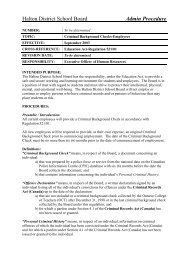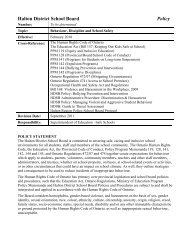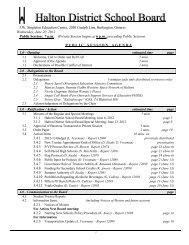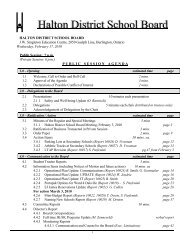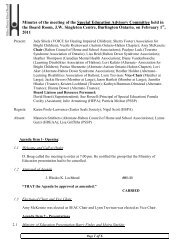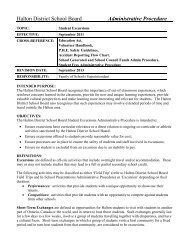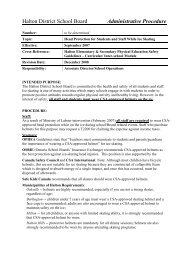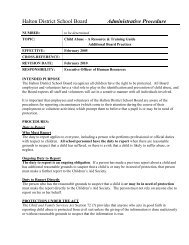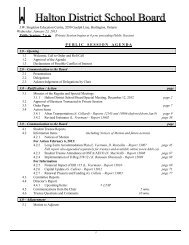2006-2007 Accessibility Plan - Halton District School Board
2006-2007 Accessibility Plan - Halton District School Board
2006-2007 Accessibility Plan - Halton District School Board
Create successful ePaper yourself
Turn your PDF publications into a flip-book with our unique Google optimized e-Paper software.
• If you offer assistance, wait until your receive permission.<br />
• Offer your arm (the elbow) to guide the person and walk slowly.<br />
• Don’t touch service animals – they are working and have to pay attention at all<br />
times.<br />
• If you’re giving directions or verbal information, be precise and clear. For<br />
example, if you’re approaching a door or an obstacle, say so.<br />
• Don't just assume the individual can't see you.<br />
• Don't leave the person in the middle of a room. Show them to a chair, or guide<br />
them to a comfortable location.<br />
• Identify landmarks or other details to orient the person to the environment around<br />
them.<br />
• Don't walk away without saying good-bye.<br />
• Be patient. Things may take a little longer.<br />
Hearing impairments<br />
People who have hearing loss may be deaf or hard of hearing. Like other disabilities,<br />
hearing loss has a wide variety of degrees. People who are hearing impaired may<br />
require assistive devices when communicating. While some people may use sign<br />
language, notes or hearing aids when communicating, others may also use e-mail,<br />
pagers, TTY telephone service or Bell Canada Relay Service.<br />
Here are some suggestions to help you interact with people who have hearing<br />
impairments.<br />
• Always ask how you can help. Don’t shout.<br />
• Don’t refer to the disability, and never use phrases like “handicapped”.<br />
• Attract the person’s attention before speaking. The best way is a gentle touch on<br />
the shoulder or gently waving your hand.<br />
• Make sure you are in a well-lighted area where the person can see your face.<br />
• Look at and speak directly to the person. Address the person, not their<br />
interpreter.<br />
• If necessary, ask if another method of communicating would be easier, for<br />
example a pen and paper.<br />
• Don’t put your hands in front of your face when speaking.<br />
• Be clear and precise when giving directions, and repeat or rephrase if necessary.<br />
Make sure you have been understood.<br />
23



